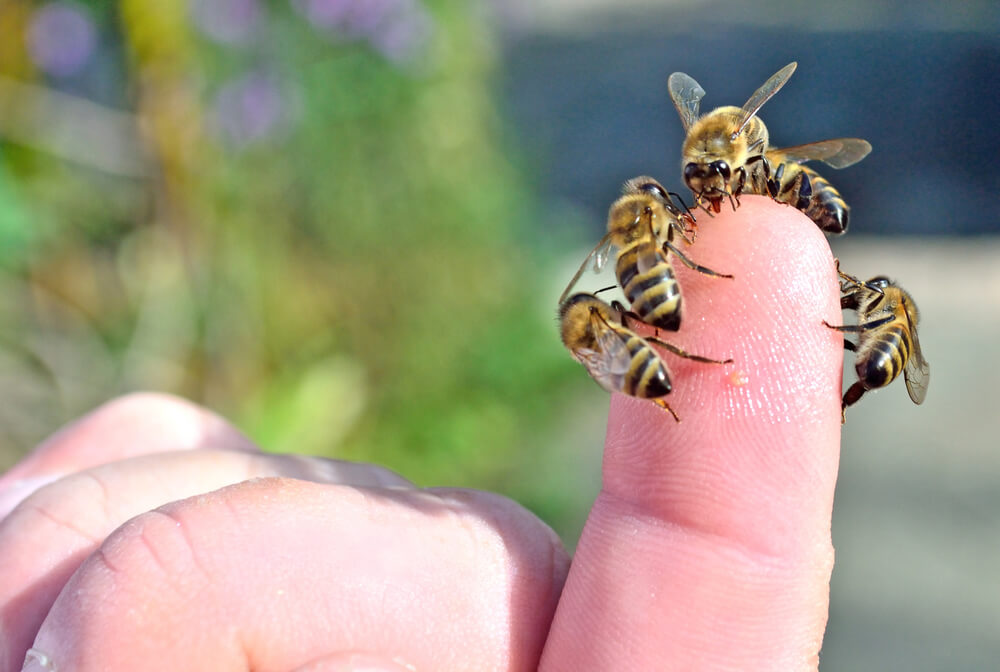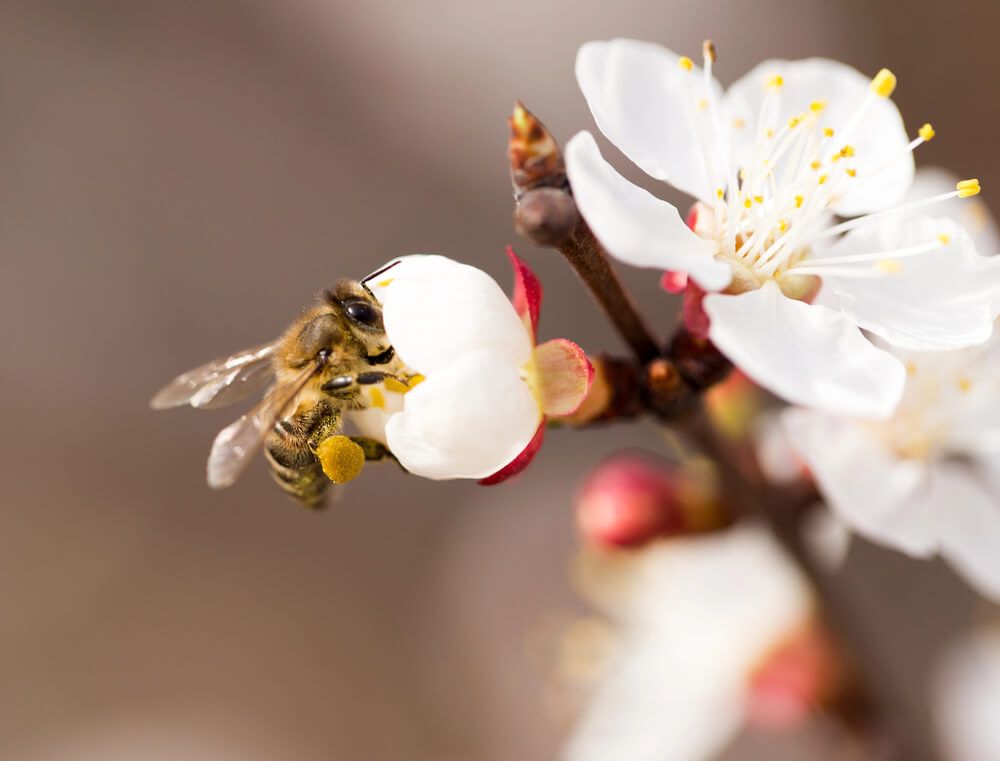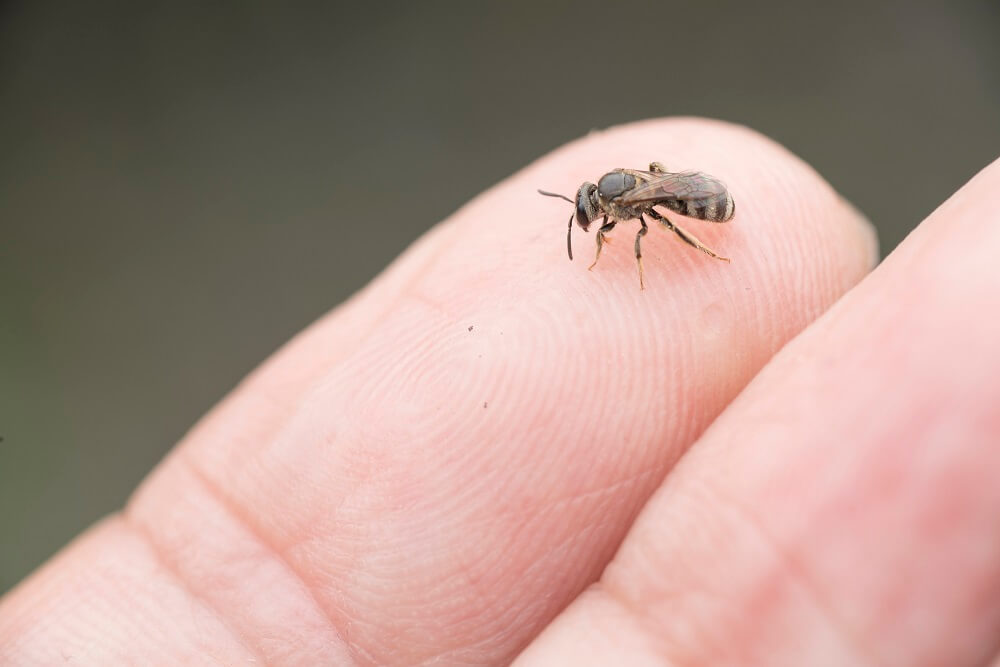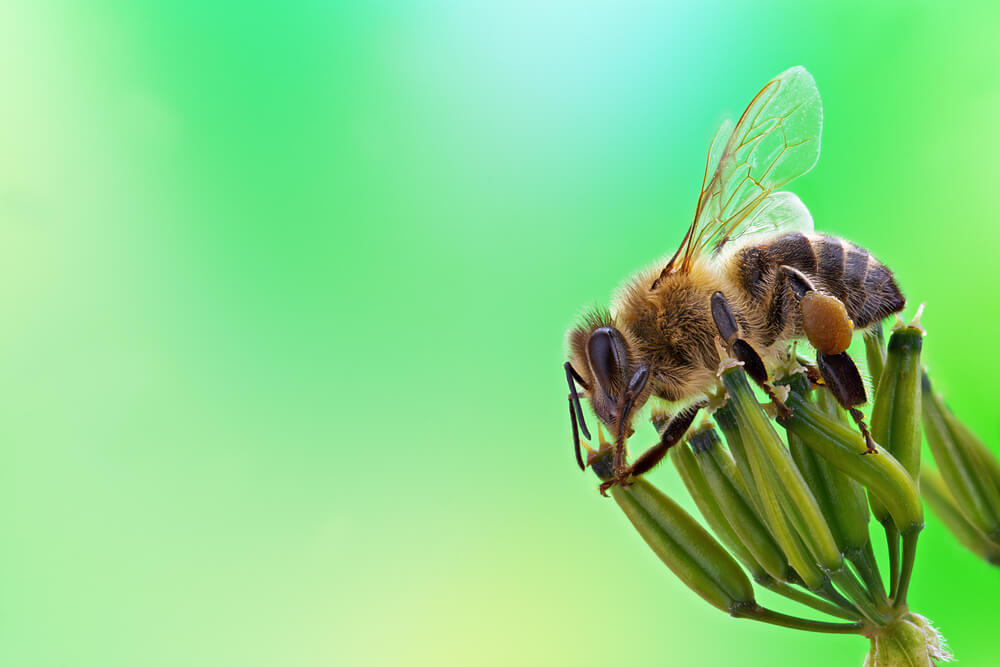Table of Contents:
Can Bees Bite Humans?
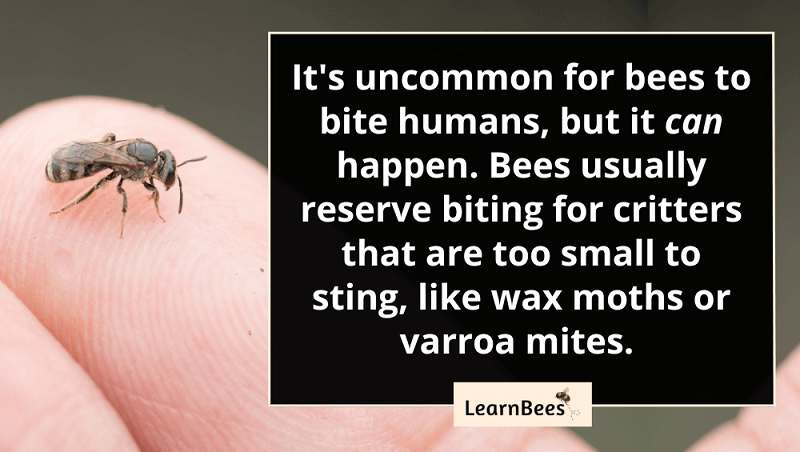
Bee can use their mandibles (jaws) to bite humans. It’s uncommon, but it does happen.
That said, I’m willing to bet that many experienced beekeepers have been bitten by a honeybee without even knowing. Most bee bites feel like a brief pinch. They’re easy to dismiss because they’re mild and don’t leave marks.
With that said, there are some exceptions to this.
Take carpenter bees, for example.
Female carpenter bees have large, strong mandibles used for drilling into wood to build their nests. They create perfectly round, half-inch holes that run about six inches deep.
Thanks to her jaw size and strength, a bite from a female carpenter bee would be more painful than a bite from a honeybee. It may even leave a tiny, red welt behind.
The same is true for leafcutter bees.
Leafcutter bees have heavy-duty mandibles used to cut leaves. In turn, they use these leaves to form their nests. Similar to carpenter bees, a bite from a leafcutter bee would pack more of a punch. Still, a bite from a carpenter bee or leafcutter bee is not as intense as a sting.
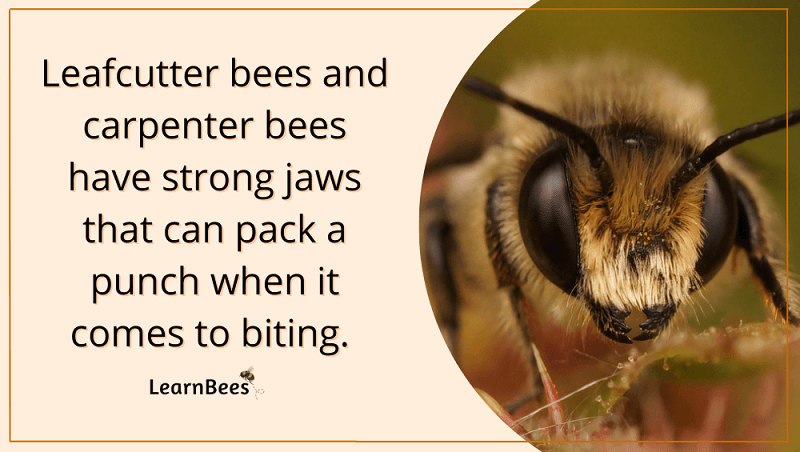
So now the question becomes…
What kind of bees bite?
All of them. There are more than 20,000 bee species worldwide, and they can all bite if needed.
Remember:
All bees have mandibles or two “jaws.”
On the end of these mandibles, bees have jagged “teeth.” These teeth aren’t like human teeth. Instead, they’re narrow, sharp points that are just extensions of the mandibles.
But here’s the thing:
All mandibles aren’t created equally.
As mentioned, some bees have mandibles used for drilling into wood. Others use them for cutting leaves. This is why we see some bee species with simple mandibles with few teeth, whereas others have many teeth that are pointy and jagged.
For example, drone honeybees (males) have small mandibles compared to their female counterparts. As such, a bite from a male honeybee wouldn’t feel like much.
Now that brings us to our next question…
Why Do Bees Bite?
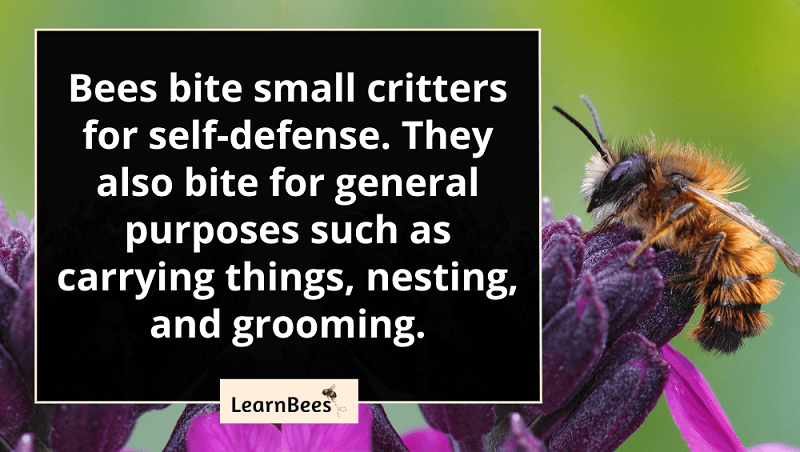
It’s hard to know what’s going through a bee’s head while it bites a human. However, it’s safe to assume the bee is acting in self-defense.
That said, it’s a bit strange to consider that bees bite. After all, why wouldn’t they just use their stingers?
It’s a good question.
For one, we have to understand that biting is natural for bees. In fact, biting is a common form of defense bees use against other insects.
For example, varroa mites are one of the most destructive pests of managed honeybee colonies. They look like tiny ticks that weaken and kill honeybees by feeding off their bodies.
Honeybees have been known to bite, claw, and scrape varroa mites off their bodies. This biting behavior is known as grooming, and it’s a crucial defense against varroa mites.
Better yet?
Scientists have discovered that honeybee bites release a chemical called 2-Heptanone. This chemical temporarily paralyzes the victim so the honeybee can remove it from the hive.(1)
For instance, this allows honeybees to bite, paralyze, and remove wax moths trying to harm their hive.(2)
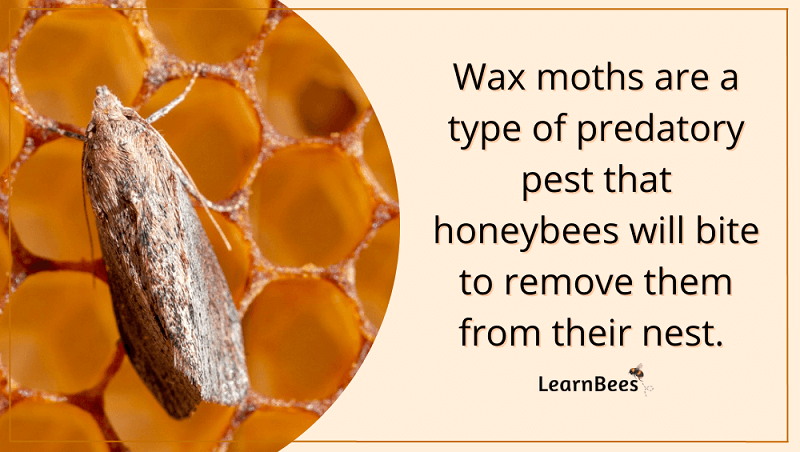
But that’s only the tip of the iceberg.
Bees bite for more than just self-defense.
We already mentioned that certain bees use their mandibles to bite into wood or leaves for nesting. But bees also bite out of their cell to emerge as adult bees. In fact, biting is the first thing worker honeybees do when it’s their time to emerge.
How does she do it?
She uses her mandibles to chew her way out of the cell. Once she’s out, the freshly emerged honeybee uses her mandibles to clean debris from the cell walls. This polishes and smooths the cell, so it can be reused for the next bee to be born.
Meanwhile:
Other worker honeybees are busy using their mandibles to repair damaged beeswax by chewing, biting, and molding it into the hexagonal shapes we’re familiar with.
What’s the Difference Between a Bee Bite and Sting?
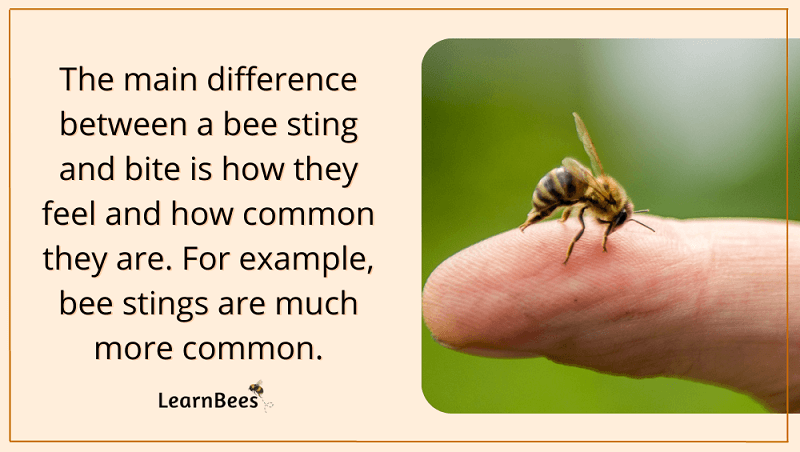
The main differences between a bee bite and a sting are how they feel and how common they are.
As mentioned, bees rarely bite humans. Bees are more likely to bite harmful critters that are too small to sting, such as varroa mites and wax moths.
Additionally, bees bite for more than just self-defense. They use their mandibles to bite and chew things, like when they’re building and cleaning their nests and carrying objects around. It’s not uncommon to see worker honeybees using their mandibles to “bite” or “carry” dead bees out of the hive.
Dead bees are unsanitary, so honeybees remove them to keep things clean.
On the other hand, bees sting for one main reason:
To protect themselves against predators.
A bee sting injects venom into the skin and can cause swelling, redness, and itching symptoms. Most people experience mild bee stings with symptoms that disappear in a few hours. Others may experience moderate reactions lasting a few days.
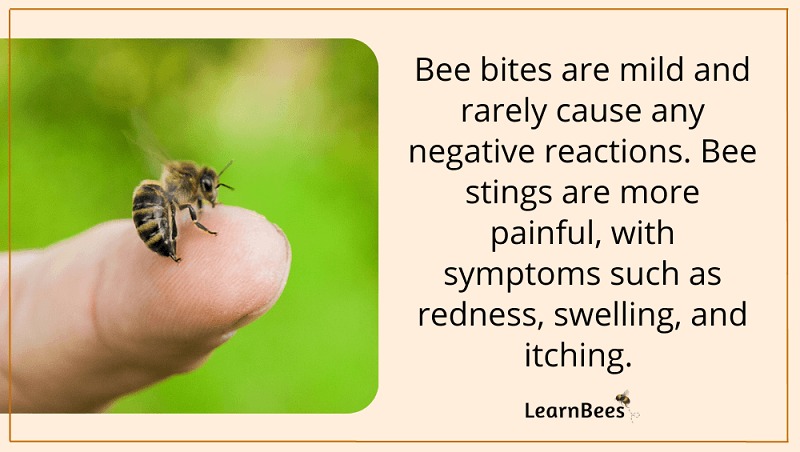
And in rare cases?
Some individuals may be seriously allergic to bee stings and require medical treatment.
But here’s a general rule:
Bees are more gentle than you might think. They get a bad rap because of their stingers.
But the truth is, bees don’t go around stinging people for no reason. Instead, they can become defensive over their nests when they feel they’re in danger. We have to remember that bees have many predators that are out to get them.
Bears, skunks, raccoons, birds, and other insects feast on bees and their honey. As such, bees have to be on high alert to protect themselves.
The good news, though, is that bees will usually back off once you give them space away from their nest.
In most cases, bees are passive-natured while they’re out pollinating flowers. I feel perfectly safe working in the garden with dozens of busy bees foraging on flowers next to me. They’re away from their nests and have nothing to protect.
Sometimes bees will even land on me briefly, then fly away without stinging.
FAQs on Bees That Bite
- What kind of bees bite?
- Are there bees that bite instead of sting?
- What happens if a bee bites you?
- Why do bees bite you?
- Can a bumblebee bite you?
- Can a honeybee bite you?
- Can a carpenter bee bite you?
- What looks like a bee but bites?
- Can native bees bite?
- Do ground bees bite?
- How do you prevent bees from biting you?
- What does a bumblebee bite look like?
What kind of bees bite?
There are more than 20,000 bee species, and all of them can bite.
Bees bite with their mandibles, which are jaws used for defense, grooming, nesting, and general activities like moving things around. That said, most bees rarely bite humans. Instead, bees will usually sting humans if they feel threatened.
Beekeepers and entomologists are the two groups that most commonly experience biting bees.
Funny thing, though. Many experienced beekeepers have been bitten by honeybees without even realizing it. A honeybee bite feels like a slight twinge of pain, and it’s easily overlooked.
—> Go back to the FAQs on bees that bite
More to Explore:
Are there bees that bite instead of sting?
Some bee species are more likely to bite than others.
For example, that are a group of stingless bees known for their biting habits. These bees are common in tropical climates. The repeated biting from stingless bees can be painful and cause small, red spots on the skin.
However, stingless bees are typically passive-natured and won’t bite unless you disturb their hive.
—> Go back to the FAQs on bees that bite
More to Explore:
What happens if a bee bites you?
Most bee bites are harmless and cause little to no reaction.
You may experience some redness around the bite, but most people don’t even experience that. Bee bites don’t release venom like bee stings do.
However, honeybee stings have been known to release a chemical called 2-Heptanone, which helps them paralyze tiny insects like wax moths and varroa mites. But, this chemical is not strong enough to cause that sort of reaction amongst humans.
—> Go back to the FAQs on bees that bite
More to Explore:
Why do bees bite you?
Bees usually bite humans out of self-defense.
As we mentioned, some bee species are more prone to biting than others. Sugarbag bees (Tetragonula carbonaria) are a type of stingless bee native to Australia. They’re tiny bees that use biting as their method of self-defense.
But don’t be alarmed.
Biting bees is uncommon, and you’re unlikely ever to experience one.
—> Go back to the FAQs on bees that bite
More to Explore:
Can a bumblebee bite you?
Bumblebees aren’t known for their biting habits but can bite humans if needed. They’re more likely to sting if you go poking around their hive. They only do this to protect their nest against intruders.
—> Go back to the FAQs on bees that bite
More to Explore:
Can a honeybee bite you? Do honeybees bite humans?
Honeybees can and sometimes do bite humans. With that in mind, beekeepers and entomologists are typically the only ones that experience honeybee bites.
And the interesting thing about it is this:
Most beekeepers and entomologists don’t even realize they’ve been bitten.
If you’re around bees for any time, chances are, you’ll get stung and bit at some point. Bee enthusiasts are pretty used to this, so they don’t think twice about it. It’s possible to get bit by a honeybee and feel nothing more than a twinge of pain. As a result, you move on with your day without worrying about it.
—> Go back to the FAQs on bees that bite
More to Explore:
Can a carpenter bee bite you?
Carpenter bees can bite, yes. But is it likely? Not at all.
Carpenter bees are known as “gentle giants” because of their reluctance to sting or bite. They’re one of the most docile bee species out there.
—> Go back to the FAQs on bees that bite
More to Explore:
What looks like a bee but bites?
Horseflies are the most common example of a biting insect that may resemble a bee. However, bees and horseflies aren’t the same. Bees feed on pollen and nectar. Female horseflies feed on blood from animals and humans. Horsefly bites can be painful and cause redness.
—> Go back to the FAQs on bees that bite
More to Explore:
- Ground Bees: Are They a Threat to Your Yard?
- Wasps vs. Honeybees: Are They Different?
- Do Bumble Bees Bite?
Can native bees bite?
Native bees include carpenter bees, mason bees, bumblebees, and sweat bees. These bees can bite, but they’re unlikely to do so.
Biting is something bees use for creatures that are too small to sting, such as tiny insects.
—> Go back to the FAQs on bees that bite
More to Explore:
Do ground bees bite?
Ground bees are equipped with mandibles that can be used for biting, however, it’s uncommon for ground bees to bite humans.
These bees are timid by nature. They’re more likely to sting humans if they feel threatened or if their nest is disturbed.
—> Go back to the FAQs on bees that bite
More to Explore:
- Do Carpenter Bees Pollinate?
- How Long Do Bumble Bees Live?
- Honeybees vs. Bumblebees: How Do They Compare?
How do you prevent bees from biting you?
In most cases, no prevention is necessary because bees biting humans is so rare. Bees are more likely to sting in self-defense than bite.
—> Go back to the FAQs on bees that bite
More to Explore:
- Do Queen Bees Eat Honey?
- Are Worker Bees Male or Female?
- Queen Bee Versus Worker Bees – How Do They Compare?
What does a bumblebee bite look like?
Bumblebee bites tend to go unnoticed because they’re so small. However, you may see a tiny red mark where the bee bit you.
